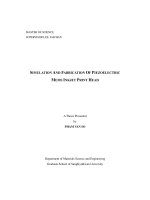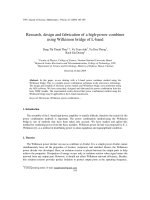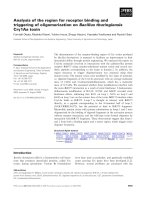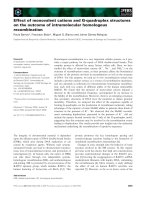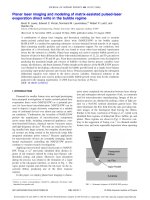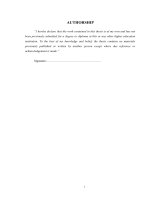Laser microprocessing and fabrication of structures on glass substrates
Bạn đang xem bản rút gọn của tài liệu. Xem và tải ngay bản đầy đủ của tài liệu tại đây (5.55 MB, 168 trang )
LASER MICROPROCESSING AND FABRICATION OF
STRUCTURES ON GLASS SUBSTRATES
HUANG ZHIQIANG
NATIONAL UNIVERSITY OF SINGAPORE
2010
LASER MICROPROCESSING AND FABRICATION OF
STRUCTURES ON GLASS SUBSTRATES
HUANG ZHIQIANG
(B. Eng. (Hons), National University of Singapore)
A THESIS SUBMITTED
FOR THE DEGREE OF DOCTOR OF PHILOSOPHY
DEPARTMENT OF ELECTRICAL AND COMPUTER ENGINEERING
NATIONAL UNIVERSITY OF SINGAPORE
2010
Acknowledgement
i
ACKNOWLEDGEMENTS
I would like to express my earnest gratefulness to my supervisor, A/Prof. Hong
Minghui, for his guidance and support during my course of study. The useful and invaluable
advices have made it possible for me to complete this thesis so smoothly. I also appreciate
the help and the personal lessons he has given me along the way.
I would also like to thank Dr. Lap Chan and Dr. Ng Chee Mang for believing in me
and giving me a chance to do this project. I have benefitted and learnt much during the
weekly student meeting. I would also like to thank Dr. Lin Qun Ying who so readily
accepted to be my mentor in the company and has given me many opportunities along the
way.
I would also like to thank my friends and colleagues in ECE-DSI Laser
Microprocessing Lab and DSI for the countless help and useful discussion they have given
me. They are always a ready source of ideas and solutions to my problems, both work and
non-work related. I cherished my time with them.
I thank my wife for her great encouragement, understanding and moral support
during these years. Her constant assurance gives me strength to carry on. My heartfelt
thanks to my dad and mum and my family members too, who showed their support in subtle
yet encouraging ways.
Lastly, I would like to thank and acknowledge with gratitude the scholarship
GLOBALFOUNDRIES Singapore Pte Ltd has provided me during the course of my Ph.D
candidature.
Table of contents
ii
TABLE OF CONTENTS
ACKNOWLEDGEMENTS i
TABLE OF CONTENTS ii
SUMMARY v
LIST OF TABLES viii
LIST OF FIGURES ix
NOMENCLATURE xvii
CHAPTER 1 INTRODUCTION 1
1.1. Properties of glass 1
1.1.1. Optical properties 1
1.1.2. Mechanical properties 4
1.2. Methods for glass processing 5
1.2.1. Mechanical scribing and breaking 6
1.2.2. CO
2
laser cutting 6
1.2.3. Waterjet cutting 7
1.2.4. Photolithography 7
1.2.5. Direct laser ablation 8
1.2.6. Laser Induced Plasma Assisted Ablation (LIPAA) 9
1.2.7. Laser Induced Backside Wet Etching (LIBWE) 9
1.2.8. Large area micro-/nano-processing 10
1.3. Applications of periodic arrays of micro-/nano-structures 11
1.4. Objectives and motivation 13
1.5. Research contribution 14
1.6. Thesis outline 16
1.7. Reference 18
Table of contents
iii
CHAPTER 2 HIGH QUALITY MICRO-PROCESSING OF GLASS
SUBSTRATES BY
LIBWE 25
2.1. Introduction 25
2.2. Etching mechanism of LIBWE 25
2.3. Experimental procedure for LIBWE 27
2.3.1. Type of laser used and raster scan by galvanometer 27
2.4. Results and discussion: Organic absorbing solution 29
2.4.1. Effect of absorbing liquid 29
2.4.2. By-product formation and removal by laser cleaning 34
2.4.3. Applications in micro-fluidic chips 38
2.5. Results and discussion: Inorganic absorbing solution 42
2.5.1. Direct etching of glass using copper (II) sulphate solution 42
2.5.2. Mechanism of the glass etching by laser irradiation of copper (II) sulphate
solution 47
2.5.3. Dicing structures of various shapes from glass substrate 48
2.6. Reference 50
CHAPTER 3 FABRICATION OF NANOHOLES ARRAY ON GLASS BY LASER
INTERFERENCE LITHOGRAPHY 54
3.1. Introduction 54
3.2. Experimental 56
3.2.1. Process flow 56
3.2.2. LIL setup and exposure 58
3.2.3. Transfer of patterns from photoresist to Cr layer 61
3.2.4. Transfer of nanoholes array patterns from Cr layer to quartz substrate 63
3.3. Applications 65
3.3.1. Nanoholes arrays as a phase mask 65
3.3.2. Potential applications of the patterned nanoholes array 69
3.4. Reference 77
CHAPTER 4 FABRICATON OF MICRO-OPTICS ON GLASS 81
4.1. Introduction 81
4.2. Fabrication of microlens array 82
4.2.1. Sample preparation 86
4.2.2. Expose of photoresist and reflow 86
4.2.3. Transferring the photoresist shape to the substrate 89
Table of contents
iv
4.3. Introduction to solid immersion lens 93
4.4. Fabrication of the micro-solid immersion lens 97
4.5. Applying the h-µSIL to improve the resolution of a MLA 101
4.5.1. Spot size analyses 103
4.5.2. Intensity profile of projected lines 105
4.5.3. Projection of ‘+’ shape 107
4.6. Reference 110
CHAPTER 5 PARALLEL MICRO-/NANO-PATTERNING BY
LASER MLA LITHOGRAPHY 112
5.1. Introduction 112
5.1.1. Microlens array lithography 112
5.2. Experimental 114
5.2.1. Sample preparation 114
5.2.2. Experimental setup 115
5.3. Results and discussion 116
5.3.1. Arbitrary patterning 116
5.3.2. Arbitrary angle patterning 118
5.3.3. Resist trimming 121
5.3.4. Patterning and etching for phase mask fabrication 125
5.3.5. Laser MLA lithography using the fabricated MLA 134
5.4. Reference 137
CHAPTER 6 CONCLUSIONS AND FUTURE WORK 139
6.1. Conclusions 139
6.2. Recommendation for future work 142
APPENDIX 144
LIST OF PUBLICATIONS
Summary
v
SUMMARY
Glass is a useful and important material which has many uses in modern society,
ranging from microelectronics, solar cells, optical engineering, biomedical to everyday
appliances. It has excellent physical properties, such as high transparency in a wide
wavelength range, strong resistance to thermal and mechanical stress, and high chemical
stabilities. Failure in glass usually starts from a crack, which then progresses to eventual
failure of the whole glass surface. Therefore, this makes the quality processing of glass
challenging. On the other hand, advances in technology have created the need for micro-
and nano-structures. Conventional methods of processing glass are insufficient to fabricate
these micro- and nano-structures on glass. Semiconductor processing techniques, such as
photolithography and e-beam lithography, are costly tools to own and operate. Therefore,
the goal of this thesis is to investigate alternative methods to achieve micro-/nano-
processing of glass by the use of advanced lasers technologies. The methods are aimed to be
cost-effective and easy to be implemented.
Laser direct writing of glass with the assistance of absorbing liquids is investigated.
The effects of the laser and the absorbing liquid on the etching process are studied. By using
a mixture of organic substances, the absorption of the laser light is improved. This helps to
increase the etch rate and decrease the threshold to initiate etching. By-products are formed
during the process and dry laser cleaning using the same laser source is successfully
developed to remove the by-products. The method is then employed to fabricate high quality
micro-structures for micro-fluidics applications. Two different approaches are investigated.
The first approach forms the micro-fluidic channels at the laser written areas while the
Summary
vi
second approach forms the structures by removing away the unwanted areas. The technique
is further extended to the use of an inorganic liquid and a cost-effective near infra-red laser.
An etching mechanism is proposed based on the deposition of metal during the process.
Miniature arbitrary shapes are diced out from glass substrates, which are challenging to be
accomplished by other conventional methods.
Laser interference lithography (LIL) is investigated as a maskless and parallel
processing method to structure glass substrates. Large array of periodic patterns can be
fabricated. The LIL technique is successfully used to process quartz with an array of
nanoholes. The nanoholes array is of high quality and uniformly over a large area. The
processed quartz is then used for phase mask applications. Using the processed quartz as a
phase mask, nanoholes array can be replicated in a single exposure. Defect engineering
capabilities are also demonstrated. Simulation is carried out and the results match the
experimental results very well.
Laser microlens array lithography is explored for patterning glass with parallel and
direct writing capabilities as well. Arrays of arbitrary patterns can be fabricated rapidly with
this technique. It is used to fabricate arbitrary phase shift structures on glass. By etching to a
depth with 180° phase difference, destructive interference is introduced. Using a 365 nm
UV light for exposure of the phase shift structures, array of patterns with much smaller
feature sizes are obtained. Through the control of the exposure time, different sets of results
can be obtained using the same array of patterns. This shows that there is flexibility in the
design and patterning process. Simulation results also match the experimental results very
well.
Summary
vii
Micro-optics is formed on glass substrates using photoresist melt and reflow method.
A MLA is successfully fabricated on glass substrate and characterized. The same technique
is used as a novel method to fabricate an array of micro-solid immersion lens array. It is
then applied to a MLA and demonstrated to be functional and able to increase the resolution
of the MLA.
List of tables
viii
LIST OF TABLES
Table 4.1. The etching cycle used to transfer the photoresist onto the fused silica
substrate.
Table 4.2 Comparison between the magnification enhancements of the two SILs.
Table 5.1. Comparison between the lateral and vertical etching rates in the resist
trimming process.
.
List of figures
ix
LIST OF FIGURES
Fig. 2.1. The chamber for LIBWE experiment. The inlet is for filling up with the
absorbing liquid.
Fig. 2.2. UV-Vis spectra of toluene and pyrene dissolved in toluene at a concentration
of 0.4 M.
Fig. 2.3. Comparison between the etched depths achieved by different liquids. The
graph of pyrene/toluene solution shows a lower etching threshold and a
deeper etched depth, implying higher etching rate.
Fig. 2.4. Various depth profiles obtained in a single laser scan at varying laser
fluencies.
Fig. 2.5(a). The binding energy of carbon at 284.65 eV, 286.19 eV and 288.94 eV, which
correspond to C-C / C-H, C-O and C=O bonds, respectively.
Fig. 2.5(b). The binding energy of oxygen at 532.51 eV and 533.17eV, which correspond
to O-Si / O-C and O=C bonds, respectively.
Fig. 2.5(c). The binding energy at 103.18 eV is due to Si-O bonds, from the quartz
composition.
Fig. 2.6. Comparison between two substrate surfaces along the micro-fluidic channel
with and without laser cleaning.
Fig. 2.7(a). Profile scans of the microfluidics channels. Uniform cross-sections are
obtained.
Fig. 2.7(b). Zoomed in 3D view of the bifurcating junctions. The depth is uniformed
etched and the edges are crack-free.
List of figures
x
Fig.2.7(c). Grooves fabricated on glass surface. The surrounding unwanted areas are
milled away using LIBWE.
Fig. 2.8. The absorption spectrum of copper (II) sulphate solution. There is
transmission in the 300 nm ~ 600 nm range, and it absorbs strongly in the
NIR range.
Fig. 2.9(a). Survey scan of the surface after the irradiation of 1064 nm laser light. The
survey scan shows the presence of Cu, C, O, and Si.
Fig. 2.9(b). Narrow scan of the Cu2p peak. The position of the Cu2p
1/2
and Cu2p
3/2
shows
the presence of metallic Cu.
Fig. 2.10. Microscopic view of the glass surface in contact with CuSO
4
solution after
the laser irradiation. There are materials deposited along the line edges.
Fig. 2.11. A schematic illustrating the process of glass material removal by continuous
irradiation of laser.
Fig. 2.12. (Top and bottom left) Glass substrates with a star and a circle diced out. The
glass substrates have remained intact after the laser processing. (Top right)
Circles of diameters 2 mm, 5mm, and 1.5 mm, from left to right, diced out
from glass substrates. (Bottom right) Different structures cut out from the
glass substrate, showing the star shape and the alphabets ‘C’ and ‘G’.
Fig. 3.1. Schematic illustration of a standing wave formed by the interference of two
light beams.
Fig. 3.2. Process flow for patterning the quartz surface.
Fig. 3.3. Schematic drawing of a Lloyd’s mirror setup for laser interference
lithography of periodic structures on photoresist.
List of figures
xi
Fig. 3.4. Illustration of the reflection angle of the reflected ray and the angle of
interference.
Fig. 3.5(a). Line array fabricated by a single exposure on negative photoresist.
Fig. 3.5(b). Nanohole array obtained after a LIL double exposure on negative photoresist.
Fig. 3.6. AFM profile of the photoresist pattern after a double LIL exposure and RIE
to open the SiO
2
capping layer.
Fig. 3.7. Nanoholes array patterns transferred to the Cr hard mask layer.
Fig. 3.8. The processed quartz substrate with the nanoholes array etched transferred to
the substrate.
Fig. 3.9. A schematic illustration of the phase delay introduced to the wave front after
passing through the surface with the nanoholes. This results in a modulation
of the wave front.
Fig. 3.10. Simulation result of the light distribution after light passes through the
surface with the nanoholes array. The modulation of the phase of the light
causes the redistribution of the light energy, resulting in a periodic array of
enhanced light intensities.
Fig. 3.11. Periodic array of nanoholes patterned uniformly on the photoresist The top
right inset shows the profile of the nanoholes formed. The bottom inset shows
the exposure method.
Fig. 3.12. The nanoholes array patterned on photoresist transferred to the silicon
substrate with good fidelity and uniformity.
Fig. 3.13. A defect formed on photoresist. The right inset shows the corresponding
defect on the quartz phase mask.
List of figures
xii
Fig. 3.14. Simulation result of a defect among the nanohole array. The defect reduces
the light intensity of that region.
Fig. 3.15. SEM image of the line of defects created on the phase mask by FIB.
Fig. 3.16. Light intensity distribution at various Z planes. This 3D distribution of light
has interesting applications in 3D photonic crystals patterning.
Fig. 4.1. Fabrication steps for fabricating a microlens array using the photoresist
reflow method.
Fig. 4.2. The plot of f versus D at three different photoresist thicknesses.
Fig. 4.3(a). Photoresist pattern array formed after the double exposure by a chrome-on-
glass mask.
Fig. 4.3(b). After the melting, the photoresist patterns are reflowed into a spherical
profile.
Fig. 4.4. Illustration showing the need to totally transfer the photoresist pattern profile
to fused silica.
Fig. 4.5. AFM profile of the MLA transferred from the photoresist onto the fused
silica substrate.
Fig. 4.6. The fabricated MLA focused the incident light into an array of focused spots.
The spot size is measured as ~ 660 nm.
Fig. 4.7. The hemispherical configuration, where the incident light focused at the
centre of the sphere.
Fig. 4.8. Illustration showing how a half sphere can be used as a hemispherical solid
immersion lens for higher resolution imaging.
List of figures
xiii
Fig. 4.9. The aplanatic point of the sphere, where the incident light focuses at the point
Z
0
. It has a virtual focus at Z
1
.
Fig. 4.10. A super-hemispherical solid immersion lens used for the sub-surface imaging.
Fig. 4.11. The concept of the fabrication of a h-µSIL. The hemispherical centre of the
h-µSIL is offset to the back of the glass substrate.
Fig. 4.12. SEM image of the fabricated h-µSIL.
Fig. 4.13. Plot of the measured sag height of the h-µSIL. The sag height is ~ 3.4 µm
while the diameter is ~ 72 µm.
Fig. 4.14. The schematic drawing of the alignment setup used to align the h-µSIL to the
MLA.
Fig. 4.15. Alignment process showing the intentional offset between the h-µSIL and the
MLA.
Fig. 4.16(a). Spot size produced by the MLA before the attachment of h-µSIL. The spot
size is ~ 1.9 µm.
Fig. 4.16(b). The spot size produced by the MLA after the attachment of the h-µSIL. The
spot size reduced to ~ 1.3 µm.
Fig. 4.17(a). An array of 4 lines projected by the MLA. The same array of 4 lines is
projected by the MLA before and after the attachment of the h-µSIL.
Fig. 4.17(b). The width of the lines projected by the MLA without the h-µSIL and
measured by the beam analyzer.
Fig. 4.17(c). The same array of 4 lines projected by the MLA with the h-µSIL attached.
The width of the lines decreases to ~ 3 µm.
Fig. 4.18(a). An array of ‘+’ sign projected by the MLA without the h-µSIL array attached.
List of figures
xiv
Fig. 4.18(b). An array of ‘+’ sign projected by the MLA with the h-µSIL array attached.
The ‘+’ shapes are smaller due to the reduction effect of the h-µSIL.
Fig. 5.1. Illustration of the concept of laser MLA lithography.
Fig. 5.2. An array of dots formed after laser light irradiation through a MLA.
Fig. 5.3. Experimental setup for the laser MLA lithography.
Fig. 5.4. Microscope image of the MLA used in the experiment. The period of the
MLA is 50 µm.
Fig. 5.5(a). A logo array pattern fabricated on fused silica by the laser MLA lithography
and RIE.
Fig. 5.5(b). Generic IC design fabricated by laser MLA lithography on fused silica. The
inset shows the 3D AFM image of an unit cell after the patterns were
transferred to the fused silica.
Fig. 5.6. Schematic drawing of laser MLA patterning by moving the nanostage at an
angle to the horizontal axis.
Fig. 5.7. Line array patterns with different periods obtained by changing the angle of
the traverse direction.
Fig. 5.8. The left figure shows the feature size obtained after the laser MLA
lithography. The right figure shows the further reduced feature size obtained
after the resist trimming.
Fig. 5.9. Process flow to incorporate the resist trimming.
Fig. 5.10. Destructive interference occurs at the edges of the phase shift structures [5],
resulting in lower light intensities at the edges.
List of figures
xv
Fig. 5.11. An array of ‘L’ shapes patterned using the laser MLA lithography and RIE.
The inset shows the 3D AFM image of a ‘L’ shape. The surface is uniform,
showing good control of the height uniformity.
Fig. 5.12. By using the fabricated phase shift structures for UV exposure, periodic
arrays of ‘double L’ are obtained.
Fig. 5.13. Simulated result showing the regions of intensity minimum at the edges of
the structures (white dashed lines), due to the destructive interference of light.
Fig. 5.14. An array of square shape phase shift structures fabricated on fused silica. The
inset shows the 3D AFM image of one of the structure. It showed the through
hole at the centre and the uniform height.
Fig. 5.15. Two concentric square patterns formed on photoresist. The smaller square is
due to the interior edge of the square phase structure while the bigger square
is due to the exterior edge.
Fig. 5.16. Simulated result showing the intensity under the square phase shift structure
as light passes through. There are two regions of low light intensities (dotted
lines), one at the exterior edge and the other at the interior edge. The through
hole concentrates the light at the centre of the square.
Fig. 5.17. By increasing the exposure time, the interior smaller square patterns on
photoresist can be deliberately exposed, leaving behind only the exterior
bigger square.
Fig. 5.18. An array of ‘L’ patterned by laser MLA lithography using the fabricated
MLA. The feature size is ~ 580 nm.
List of figures
xvi
Fig. 5.19. An array of 3 ‘L’s patterned parallel to one another. The minimum feature
size is ~ 440 nm. The space between the ‘L’s can still be distinguished.
Nonmenclature
xvii
NONMENCLATURE
T
0
Transmission
κ
Extinction coefficient
λ
Wavelength
α
Absorption coefficient
M
Molar
F
Laser fluence
p
Period
θ
Angle of interference / Angle of
incidence
n
Refractive index
h
Height of the nanholes / phase shift
structures
φ
Phase difference
d
Diameter of nanoholes
Z
T
Talbot length
c
Lattice constant
x
Distance
γ
Angle of traverse (Parallel patterning)
s
Sag height of photoresist
/ microlens
D
Diameter of lens / photoresist islands
t
Thickness of photoresist
J
1
Bessel function of the first kind
I
Intensity
I
0
Maximum intensity
k
Wavenumber
β
Angle of observation
a
Radius of aperture
l
Resolution limit
R
Radius of curvature
f
Focal length
T
Temperature
P
Pressure
Z
0
Aplanatic point of sphere
NA
Numerical aperture
Chapter 1: Introduction
1
CHAPTER 1
INTRODUCTION
Glass is one of the important industrial materials today. It is used in many different
fields, such as building, automotives, electronics, lighting and optics. Glass is a uniform
amorphous solid material, usually produced when a viscous molten material cools rapidly to
below its glass transition temperature, without sufficient time for a regular crystal lattice to
form. Common glass contains about 70 ~ 72 weight % of silicon oxide (SiO
2
). The major
raw material is sand that contains almost 100% of crystalline silica in the form of quartz.
Even though it is an almost pure quartz, it still contains a little (<1%) iron oxides that would
color the glass, so this sand is usually enriched in the factory to reduce the iron oxide
amount to <0.05%. Large natural single crystals of quartz are purer silicon dioxide, and
upon crushing, are used for the high quality specialty glasses. Synthetic amorphous fused
silica (almost 100% pure) is the raw material for the most expensive specialty glasses. As
science and technology progress, there is an increasing demand for glass in new areas of
applications, such as flat panel display, hard disk manufacturing, biomedical, solar cell
manufacturing and micro-optics. Glass has many advantageous properties which make it
such an invaluable material for manufacturing.
Chapter 1: Introduction
2
1.1. Properties of glass
The properties of glass can be varied and regulated over an extensive range by
modifying the composition, production techniques, or both. These procedures fix the
molecular structure of the glass and determine its interaction with the electromagnetic
waves. The important properties of glass are its mechanical, optical, and thermal properties.
These properties of glass are briefly discussed in the follow sections.
1.1.1. Optical properties
When a beam of light falls on a piece of glass, some of the light is reflected from the
glass surface, some of the light passes through the glass, and the rest is absorbed by the
glass. Optical components make use of these properties of glass to absorb, emit or direct
light. The important optical properties of glass are its refractive index, dispersion, and
transmission.
The refractive index of glass is the measure of the speed of light as it travels through
glass. It is expressed as a ratio of the speed of light in vacuum relative to that in the glass.
Light travels more slowly through materials with a refractive index greater that of vacuum,
which has a value of 1. As a light wave enters the glass material, it encounters repetitive
scattering and rescattering by the atoms of the materials. Among atoms, light is traveling at
the light speed, c = 3 × 10
8
m/s. However, the scattering and rescattering events introduce a
phase shift into the light field and this eventually results in an apparent slow down of the
light as it travels through the glass [1]. In glass, the apparent light speed is about 2×10
8
m/s.
Chapter 1: Introduction
3
Light undergoes refraction at the interface between vacuum and glass according to
the Snell‟s law:
1
2
2
1
sin
sin
n
n
(1.1)
where θ
1
and θ
2
are the angle to the normal for the light rays in air and glass respectively,
and n
1
and n
2
the refractive index of air and glass. This refraction of light makes it possible
to use glass for making lenses, by shaping the lens to the proper shape to focus light.
The complex refractive index can be defined as:
inn
~
(1.2)
where n is the refractive index and κ the extinction coefficient, which describes loss in the
light energy as it passes through the glass. Both n and κ are dependent on the wavelength of
the light, and because n varies with the wavelength of light, this causes dispersion in glass.
Blue light sees a larger value of n as compared to red light. Upon refraction, blue light bends
more than red light and this is the property which makes a prism able to split the white light
into its constituent colours. French mathematician, Augustin-Louis Cauchy, was the first to
formulate the dispersion with respect to the refractive index:
42
cb
an
(1.3)
with an accuracy within the visible spectrum of the order of 10
-4
[2]. Coefficients a, b and c
are then determined experimentally by measuring the refractive index at different
wavelengths. There are various other equations which relate the dispersion to the refractive
index, such as the Sellimeier equation:
Chapter 1: Introduction
4
3
2
2
3
2
2
2
2
1
2
2
1
2
1
C
B
C
B
C
B
n
(1.4)
where B
1,
B
2,
B
3
and C
1,
C
2,
C
3
are experimentally determined Sellmeier coefficients. It is
therefore an empirical formula that relates the refractive index to the wavelength of the
light, but offers higher degrees of accuracy [2].
The extinction coefficient κ in Eq. 1.2 is associated with loss of the light energy due
to absorption and scattering [3] as it propagates through the medium, and therefore directly
affects the transmission properties of glass. The transmission of light is given by the Beer-
Lambert Law:
x
i
t
e
I
I
T
0
(1.5)
where T
0
is the transmission, I
t
the transmitted light, I
i
the incident light, α the absorption
coefficient and x the distance the light has travelled. The composition which makes up the
glass material determines the amount of absorption and scattering at different wavelengths.
Therefore, a wide range of different glasses can be chosen for transmitting/absorbing light at
different wavelengths, for different applications, such as filters and windows.
1.1.2. Mechanical properties
Glass is an unusual material when subjected to mechanical stress because it returns
exactly to its original shape when the bending or stretching force is removed. This
characteristic of glass classifies it as a perfect elastic material [4]. If more force is applied,
Chapter 1: Introduction
5
the glass breaks when the force reaches the ultimate strength of the glass. But at any small
pieces of breakage, it can be found that the glass does not deform permanently.
There are three types of forces to be considered:
1. A tensile force exerts a pull on the material. A mild tensile force exerts a pull on
the material but a severe tensile force can pull the glass material apart.
2. A compressive force acts to squeeze the glass material.
3. A shear force acts on the material to slide one part of the material in one
direction and the other in the opposite direction.
Tensile force is the most important in glass because it gives rise to tensile strain
within the glass and glass breaks only from tensile tension. The strength of glass is only
slightly affected by composition but is highly dependent on surface conditions. This
explains why mechanical scribing of glass, where a scratch mark is made on the surface of
the glass, can easily aid the breakage of the glass. Strength is measured in the laboratory by
applying a load to glass. This stretches the lower surface of the glass material so that it is in
tension and squeezes the top surface, causing it to be in compression. The load is increased
until the glass breaks. The break originates in the lower surface since glass always fails from
tension.
1.2. Methods for glass processing
As discussed in the previous section, glass has excellent properties, making it an
excellent candidate for many applications. However, failure in glass usually starts from a
crack, which then progresses to eventual failure of the whole glass surface. Therefore, it is
Chapter 1: Introduction
6
challenging to process glass, especially high precision engineering. In the following
sections, methods used in the industry and research field are briefly discussed.
1.2.1. Mechanical scribing and breaking
Mechanical scribing and breaking are the classic and most prevalent glass separation
technologies. This is a process that involves the mechanical scribing of a vent in the upper
surface of the glass. This is usually accomplished with a diamond or tungsten carbide wheel.
Mechanical scribing and breaking perform reasonably well when the operational parameters
are optimized. High performance scribing requires optimization to minimize the damage to
the glass surface while maintaining a vent crack that is sufficient for a good break.
Unfortunately, maintaining control of operational parameters is often somewhat of an art,
not well understood by process engineers, and causes yield loss. The vent is created in only
the top 10 ~ 20 percent of the glass thickness. Applying a pressure on the opposite side of
the glass mechanically breaks the glass. This is generally done through an impact, roller or
guillotine breaker. The major limitation of this technology is that particulates are generated
during the scribing process along with surface damage and lateral cracks. These defects
generated during the scribing process often cause failure to the glass surface.
1.2.2. CO
2
laser cutting
CO
2
laser at a wavelength of 10.6 μm is opaque to glass as glass absorbs strongly at
this wavelength. Shining the glass surface with the laser beam precisely heats the glass at
